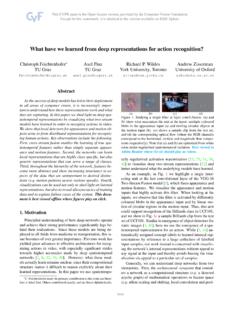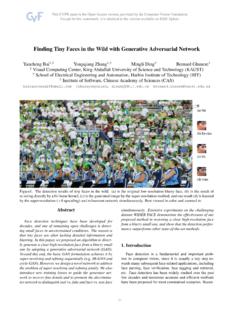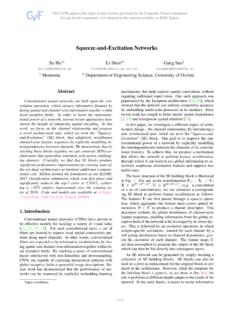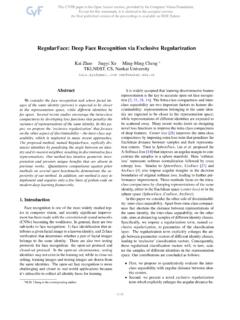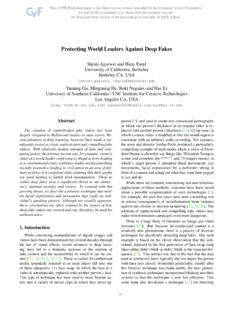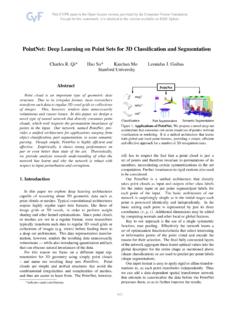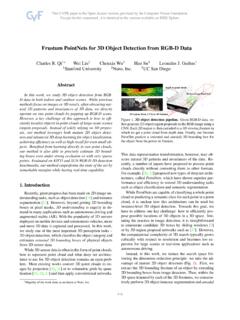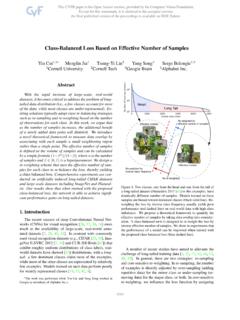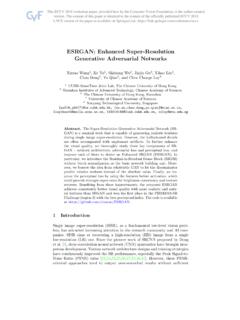Transcription of PointPillars: Fast Encoders for Object Detection From ...
1 PointPillars: Fast Encoders for Object Detection from Point CloudsAlex H. LangSourabh VoraHolger CaesarLubing ZhouJiong YangOscar BeijbomnuTonomy: an APTIV company{alex, sourabh, holger, lubing, , Detection in point clouds is an important aspectof many robotics applications such as autonomous this paper, we consider the problem of encoding a pointcloud into a format appropriate for a downstream detectionpipeline. Recent literature suggests two types of Encoders ;fixed Encoders tend to be fast but sacrifice accuracy, whileencoders that are learned from data are more accurate, butslower. In this work, we propose PointPillars, a novel en-coder which utilizes PointNets to learn a representation ofpoint clouds organized in vertical columns (pillars). Whilethe encoded features can be used with any standard 2D con-volutional Detection architecture, we further propose a leandownstream network.}
2 Extensive experimentation shows thatPointPillars outperforms previous Encoders with respect toboth speed and accuracy by a large margin. Despite onlyusing lidar, our full Detection pipeline significantly outper-forms the state of the art, even among fusion methods, withrespect to both the 3D and bird s eye view KITTI bench-marks. This Detection performance is achieved while run-ning at62Hz: a 2 - 4 fold runtime improvement. A fasterversion of our method matches the state of the art at 105 benchmarks suggest that PointPillars is an appropri-ate encoding for Object Detection in point IntroductionDeploying autonomous vehicles (AVs) in urban environ-ments poses a difficult technological challenge. Amongother tasks, AVs need to detect and track moving objectssuch as vehicles, pedestrians, and cyclists in realtime.
3 Toachieve this, autonomous vehicles rely on several sensorsout of which the lidar is arguably the most important. Alidar uses a laser scanner to measure the distance to theenvironment, thus generating a sparse point cloud repre-sentation. Traditionally, a lidar robotics pipeline interpretssuch point clouds as Object detections through a bottom-up pipeline involving background subtraction, followed byspatiotemporal clustering and classification [12,9].2040605860626466 Performance (mAP)VFSAPPAll classes2040607880828486 Performance (AP)MP+VFSCAPPCar204060 Runtime (Hz)4244464850 Performance (AP)VFSAPPP edestrian204060 Runtime (Hz)56586062 Performance (AP)VFSAPPC yclistFigure 1. Bird s eye view performance vs speed for our proposedPointPillars,PPmethod on the KITTI [5] test set.
4 Lidar-onlymethods drawn as blue circles; lidar & vision methods drawn asred squares. Also drawn are top methods from the KITTI leader-board:M: MV3D [2],AAVOD [11],C: ContFuse [15],V:VoxelNet [33],F: Frustum PointNet [21],S: SECOND [30],P+PIXOR++ [31]. PointPillars outperforms all other lidar-onlymethods in terms of both speed and accuracy by a large also outperforms all fusion based method except on performance is achieved on the 3D metric (Table2).Following the tremendous advances in deep learningmethods for computer vision, a large body of literature hasinvestigated to what extent this technology could be appliedtowards Object Detection from lidar point clouds [33,31,32,11,2,21,15,30,26,25]. While there are many similaritiesbetween the modalities, there are two key differences: 1)the point cloud is a sparse representation, while an image isdense and 2) the point cloud is 3D, while the image is a result, Object Detection from point clouds does not triv-ially lend itself to standard image convolutional early works focus on either using 3D convolu-tions [3] or a projection of the point cloud into the image12697[14].
5 Recent methods tend to view the lidar point cloudfrom a bird s eye view (BEV) [2,11,33,32]. This over-head perspective offers several advantages. First, the BEVpreserves the Object scales. Second, convolutions in BEVpreserve the local range information. If one instead per-forms convolutions in the image view, one is blurring thedepth information (Fig. 3 in [28]).However, the bird s eye view tends to be extremelysparse which makes direct application of convolutionalneural networks impractical and inefficient. A commonworkaround to this problem is to partition the ground planeinto a regular grid, for example 10 x 10 cm, and then per-form a hand-crafted feature encoding method on the pointsin each grid cell [2,11,26,32]. However, such methodsmay be sub-optimal since the hard-coded feature extractionmethod may not generalize to new configurations withoutsignificant engineering efforts.
6 To address these issues, andbuilding on the PointNet design developed by Qi et al. [22],VoxelNet [33] was one of the first methods to truly do end-to-end learning in this domain. VoxelNet divides the spaceinto voxels, applies a PointNet to each voxel, followed bya 3D convolutional middle layer to consolidate the verticalaxis, after which a 2D convolutional Detection architectureis applied. While the VoxelNet performance is strong, theinference time, , is too slow to deploy in real SECOND [30] improved the inference speed ofVoxelNet but the 3D convolutions remain a this work, we propose PointPillars: a method for ob-ject Detection in 3D that enables end-to-end learning withonly 2D convolutional layers. PointPillars uses a novel en-coder that learns features on pillars (vertical columns) of thepoint cloud to predict 3D oriented boxes for objects.
7 Thereare several advantages of this approach. First, by learningfeatures instead of relying on fixed Encoders , PointPillarscan leverage the full information represented by the pointcloud. Further, by operating on pillars instead of voxelsthere is no need to tune the binning of the vertical directionby hand. Finally, pillars are fast because all key operationscan be formulated as 2D convolutions which are extremelyefficient to compute on a GPU. An additional benefit oflearning features is that PointPillars requires no hand-tuningto use different point cloud configurations such as multiplelidar scans or even radar point evaluated our PointPillars network on the publicKITTI Detection challenges which require Detection of cars,pedestrians, and cyclists in either BEV or 3D [5].
8 Whileour PointPillars network is trained using only lidar pointclouds, it dominates the current state of the art includingmethods that use lidarandimages, thus establishing newstandards for performance on both BEV and 3D Detection (Table1and Table2). At the same time, PointPillars runsat62Hz, which is 2-4 times faster than previous state ofthe art (Figure1). PointPillars further enables a trade offbetween speed and accuracy; in one setting we match stateof the art performance at over100Hz(Figure5). We havealso released code1to reproduce our Related Object Detection using CNNsStarting with the seminal work of Girshick et al. [6], it wasestablished that convolutional neural network (CNN) archi-tectures are state of the art for Detection in images. Theseries of papers that followed [24,7] advocate a two-stageapproach to this problem.
9 In the first stage, a region pro-posal network (RPN) suggests candidate proposals, whichare cropped and resized before being classified by a secondstage network. Two-stage methods dominated the importantvision benchmark datasets such as COCO [17] over single-stage architectures originally proposed by Liu et al. [18]. Ina single-stage architecture, a dense set of anchor boxes isregressed and classified in one step into a set of predictionsproviding a fast and simple architecture. Recently, Lin etal. [16] convincingly argued that with their proposed focalloss function a single stage method is superior to two-stagemethods, both in terms of accuracyandruntime. In thiswork, we use a single stage Object Detection in lidar point cloudsObject Detection in point clouds is an intrinsically three di-mensional problem.
10 As such, it is natural to deploy a 3 Dconvolutional network for Detection , which is the paradigmof several early works [3,13]. While providing a straight-forward architecture, these methods are slow; Engelckeet al. [3] inference on a single point recent methods improve the runtime by projecting the3D point cloud either onto the ground plane [11,2] or theimage plane [14]. In the most common paradigm the pointcloud is organized in voxels and the set of voxels in eachvertical column is encoded into a fixed-length, hand-crafted,feature encoding to form a pseudo-image which can be pro-cessed by a standard image Detection architecture. Somenotable works include MV3D [2], AVOD [11], PIXOR [32]and Complex YOLO [26] which all use variations on thesame fixed encoding paradigm as the first step of their ar-chitectures.
